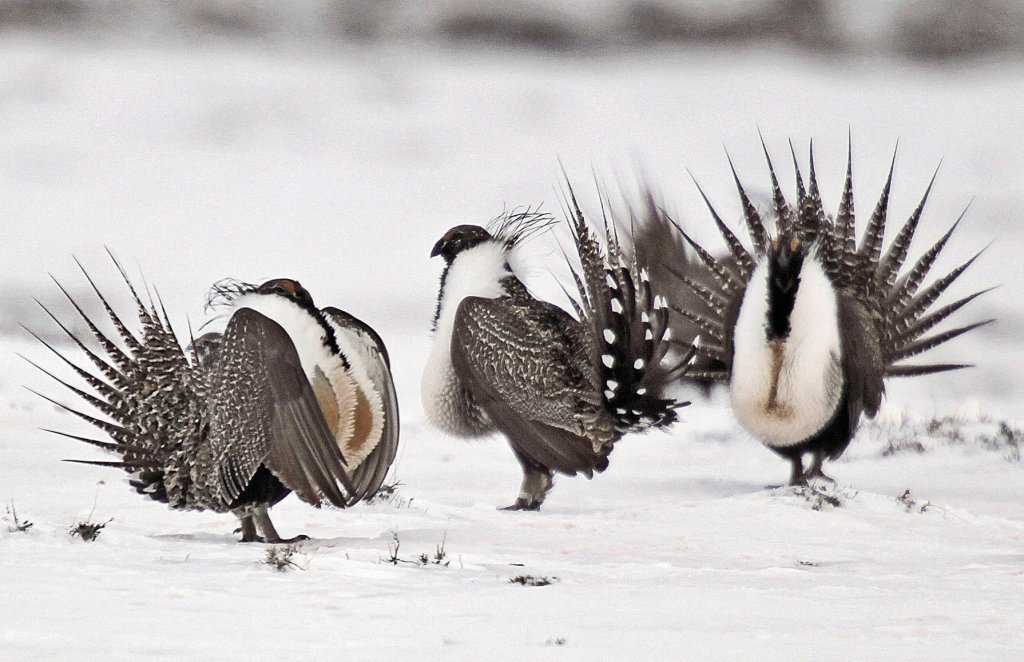BLM plan to protect sage grouse raises questions for farmers, environmentalists
Published 3:45 pm Thursday, March 14, 2024

- Male greater sage grouse perform mating rituals for a female grouse, not pictured, on a lake outside Walden, Colorado, in 2013.
The Bureau of Land Management announced plans on Thursday to increase protections for the greater sage grouse, a sensitive species of bird whose populations have fallen dramatically due to habitat loss.
Once numbering in the millions, the population of greater sage grouse has fallen to around 800,000 nationwide. Some occupy portions of Crook and Deschutes counties where sage grows in abundance.
Habitat loss caused by encroachment of farming, mining and infrastructure has been exacerbated by drought, wildfire and the spread of invasive species, the BLM said, requiring the need for stronger protections of public lands. The BLM’s proposal could impact mining, drilling and energy development across the West.
Sage grouse rely on sagebrush lands for all aspects of their life cycle to meet their needs for food, cover and reproduction, according to the BLM. A local population may need up to 40 square miles of intact landscape to stay healthy. The imperiled birds are known for their elaborate mating dance. Starting in early March, male greater sage grouse form leks, or groups, where they court females by fanning their feathers and inflating pouches on their necks.
Deschutes County asking state for $77,000 to compensate for wolf kills
The BLM says protecting sage grouse habitat will also support mule deer, pronghorn, pygmy rabbit and other sagebrush wildlife.
Matt Cyrus, president of Deschutes County Farm Bureau, said any new rules restricting grazing on public lands are a potential detriment to agriculture in Central Oregon and impacts could spread beyond ranching families.
“You’ll have a trickledown effect on the economy,” he said.
Cyrus contends that grazing doesn’t impact greater sage grouse numbers but actually improves their habitat by reducing wildfire risk — trails made by livestock act as a firebreak, he said.
“There’s pretty good documentation livestock prevent wildfires,” said Cyrus. “If you don’t burn the sage grouse they tend to do better.”
The BLM does not anticipate ranchers in Crook and Deschutes counties will see changes by the proposal.
“None of the alternatives in this draft plan call for changes to grazing on public lands the BLM manages in Deschutes and Crook counties,” said Brian Hines, a spokesperson with the BLM.
Hines said any changes are designed to help sage grouse numbers improve in Central Oregon.
“Greater sage-grouse continue to decline across their range,” said Hines. “The BLM will continue to work with diverse stakeholders to protect sagebrush and greater sage-grouse and address specific threats.”
Mark Salvo, Conservation Director at Oregon Natural Desert Association, said the new draft BLM plan is good, but not good enough.
“The Bureau’s preferred management alternative will not be enough to reverse these trends,” said Salvo in a statement.
Salvo said the plan has tools to shape a management strategy that can provide for sage-grouse and other species but improvements are needed.
“We look forward to working with the agency to strengthen conservation measures for sage-grouse and their habitat in the final plan, complementing the many other conservation initiatives underway in Eastern Oregon,” Salvo said.
A draft plan to protect the sage grouse on public lands is available on the BLM website with a public comment period opening on Friday, March 15 and closing June 13. Information on how to comment can be found at blm.gov/sagegrouse. A final impact statement is expected in the fall.





